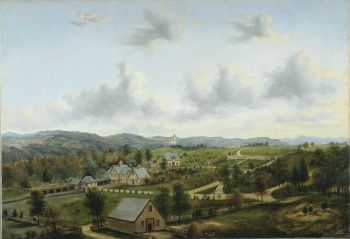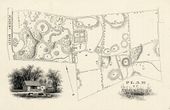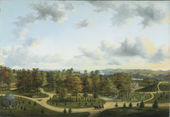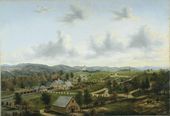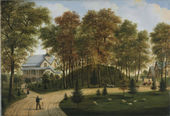Springside
Overview
Alternate Names: Springside
Site Dates: 1850–present
Site Owner(s): Matthew Vassar 1850–1868; John O. Whitehouse 1868; Eugene N. Howells 1901; Gerald Nelson 1972; Geraldine Nelson Acker 1972; Gertrude Nelson 1972; Robert S. Ackerman c. 1971; Springside Landscape Restoration 1990;
Associated People: Caleb M. Bement, manager; Mrs. Bement;
Location: Poughkeepsie, NY · 41° 41' 25.04" N, 73° 55' 55.02" W
Condition: Altered
Keywords: Avenue; Aviary/Bird cage/Birdhouse; Bridge; Cemetery/Burying ground/Burial ground; Conservatory; Deer park; Eminence; Fountain; Gate/Gateway; Icehouse; Jet; Lake; Meadow; Park; Picturesque; Pond; Rustic style; Shrubbery; View/Vista; Wood/Woods
Springside, the estate of Matthew Vassar in Poughkeepsie, New York, was designed by nurseryman, landscape designer, and author, Andrew Jackson Downing (1815-1852) at the apex of his career. It represents the most complete expression of his theory and practice. A. J. Downing was engaged in 1850 by Matthew Vassar (1792-1868), a wealthy beer brewer, philanthropist, and founder of Vassar College. Springside is one of the few projects by the partnership of Downing & Calvert Vaux (1825—1895) that has been preserved significantly intact.
History
Around 1850, the agricultural landscape of the future site of Springside attracted the interest of the Board of Trustees of Poughkeepsie who hoped to establish a rural cemetery. Matthew Vassar, already a prominent figure in the city and president of the Board, purchased the farmland called “Allan farm” to secure the location.[1] A successful businessman and founder of Vassar College, he was on the board of three different banks, president of several societies in the region, including the Hudson River Railroad and the Lyceum of Literature and Mechanical Arts and president of the Board of Trustees of the city of Poughkeepsie in 1835.[2]
Following a cholera epidemic in 1842, the need for a larger burial ground became a pressing necessity for Poughkeepsie.[3] At the time, the development of rural cemeteries was seen, according to Downing scholar Robert M. Toole, “as a reaction to the unhealthy, unattracted, and overcrowded conditions of older church yard burial plots inherited from the Colonial period.”[4] Following the model of the Mount Auburn Cemetery outside of Boston, new burial grounds were built with particular attention to the design qualities of the landscape. Downing had written about the benefits of the rural cemetery in his periodical The Horticulturist in 1849, the year before he received the commission for Springside.[5] (view text)
The site was initially considered for its location—Academy Street on the west, a wooded backdrop on the south, and surrounding grounds cleared by agriculture throughout—which contributed to its qualities as an enclosed, separate place, or as described, “a paradise,” at the same time functional and pleasing.[6] Vassar historian Benson J. Lossing recalled that while the village was still deciding whether to use the site, Vassar had begun “improvements of the property in a manner suitable for a cemetery or the pleasure-grounds of a private residence.”[7] [Fig. 1]
Vassar renamed the property Springside “because of the numerous fountains that were bubbling up here and there.”[8] When the city moved away from the idea of using this location, the property became Vassar’s own residence on which he eventually spent over $100,000, turning a farm that he had purchased for $8,000 into a celebrated estate.[9] (view text)
The plan of Springside was then in the hands of the most prominent American landscape architect of the time, A. J. Downing, who, through his popular publications, promoted a natural style for American domestic landscape design. With his partner Calvert Vaux, (1825-1895) he would design Vassar’s residence in the Gothic Revival or Hudson River Bracketed style of architecture known for its “asymmetric outline, sloping gables, irregular windows and rustic finish that existed in "harmonious combination" with a more natural, unregulated landscape.”[10] Through these features, Springside embodied Downing's principles of “variety, unity and harmony” in both architecture and landscape design.[11] This combination of natural and designed features was recalled by Calvert Vaux in 1857, while revisiting Springside. (view text)
In his biography “Vassar College and its Founder,” Lossing dedicated a lengthy description to Springside adding a plan of the park along with illustrations of notable features—such as Willow Spring and Poplar Summit. (view text)
He wrote that Springside featured an entrance with a “broad, gravely road,” as well as a deer-park, a rustic bridge, a duck-pond, a smaller pond with gold fishes, a rustic cabin roofed with pantiles, a gardener’s cottage as well as evergreen trees, meadows, shrubs, hemlock saplings, “groups of stones, among which [were] rustic seats,” a conservatory with a crystal roof, as well as a pagoda and a summer-house.[12][Fig. 2]
According to Lossing, at the time of writing in 1867, Springside was characterized by a picturesque landscape design that emphasized “the raw materials of wood, water, and surface” for a charming effect, therefore confirming Downing’s departure from the geometric style of the 18th and early 19th century.[13] Other scholars, such as Toole, see Springside as an exemplar of Downing’s Beautiful style rather than the picturesque. (view text)
Toole also argued that Vassar himself became invested in the design of the grounds as demonstrated by the literature on the subject in his library.[14] He often discussed the making of Springside with colleagues, friends, and family.[15] Whether rural cemetery or country private estate, Springside was the result of the intrinsic landscape features that attracted Downing, such as the variety of its terrain and vegetation, coupled with Vassar’s own vision for the development of his property.[16] Harvey K. Flad highlights how Springside was an ideal ground for Downing’s approach to landscape design with its balanced combination between a “park-like” and a “pastoral landscape” that could embed both “sylvan and pastoral beauty.”[17] Importantly, Downing added “utility” to a picturesque landscape that was as much as a pleasure ground as a “working farm with kitchen garden, stables, orchard, and pasture,”[18] in the tradition of the ferme ornée or ornamental farm. [Fig. 3]
In Spring 1852, the local paper The Poughkeepsie Eagle, published an “Ode to Springside,” (view text) and reported that Vassar “was beautifying the place with ornamental trees, walks, ponds, fountains etc.,” and “more than 1000 forest trees,” while the previous year “he set out a very large number of evergreen trees along the winding paths.”[19] Vassar commissioned several paintings from English landscape painter Henry Gritten that record the landscape’s features and the improvements under his stewardship. [Fig. 4] The paintings, executed in 1852, are important documents of how Downing probably last saw Springside.[20]
Many of Vassar’s contemporaries, including poets and musicians, have celebrated Springside or taken inspiration from it as the site became known. During Vassar’s lifetime he himself opened the park to visitors regularly. In 1852, Russell Comstock, a visitor of Springside, described the “pictorial” quality of the location, emphasizing the rhythm of hills, meadows and watercourses. (view text)
Vassar used Springside as a summer residence until he permanently moved there in 1864. He and his wife Catherine Valentine, lived in the caretaker’s cottage while waiting for a large villa to be built. Both were designed by Downing in 1851 and then Vaux in 1854, but were never executed.[21] After Vassar’s death, Springside remained a one-family residence through the early 1970s when it was purchased in part by Robert S. Ackerman, a developer. A request for re-zoning in 1968 alerted local preservationists who petitioned to rescue the site from the peril of commercial use. Although Springside was granted the status of National Historic Landmark in August 1969, a combination of neglect and fire destroyed all but one of the original twelve buildings. Only the Gatehouse remains. During these years, the unregulated growth of the vegetation compromised much of Downing’s original landscape plan.[22] Small improvements were made under various owners and some of the land sold. The rest was neglected, allowing Springside to remain almost intact since Vassar’s death.[23]
Today, the park is managed by volunteers of the Springside Landscape Restoration, an association that took title of the site in the 1990. The park is a National Historic Landmark comprised of 23.6 of the original 43 acres of land.
--Valeria Federici
Texts
- A. J. Downing, “Public Cemeteries and Public Gardens,” in The Horticulturist, July 1849, Volume IV, pp. 9-10.[24]
- “ONE of the most remarkable illustrations of the popular taste, in this country, is to be found in the rise and progress of our rural cemeteries.
- Twenty years ago, nothing better than a common grave-yard, filled with high grass, and a chance sprinkling of weeds and this-tles, was to be found in the Union...
- Eighteen years ago, Mount Auburn, about six miles from Boston, was made a rural cemetery. It was then a charming natural site, finely varied in surface, containing about 80 acres of land, and admirably clothed by groups and masses of native forest trees...
- No sooner was atten-tion generally roused to the charms of this first American cemetery, than the idea took the public mind by storm...
- Not twenty years have passed since that time ; and, at the present moment, there is scarcely a city of note in the whole country that has not its rural cemetery. The three leading cities in the north, New York, Philadelphia, Boston, have each of them, besides their great cemeteries-Greenwood, Laurel Hill, Mount Auburn...
- The great attraction of these cemeteries, to the mass of the community, is not in the fact that they are burial places, or solemn places of meditation for the friends of the deceased, or striking exhibitions of monumental sculpture, though all these have their influence... The true secret of the attraction lies in the natural beauty of the sites, and in the tasteful and harmonious embellishment of these sites by art.” (See Fig. 4)
- A. J. Downing, “Our Frontispiece,” in The Horticulturist, February 1851, Volume VI, p. 98.[25]
- “OUR FRONTISPIECE.-We present our read-ers, this month, with a perspective view and ground plan of a barn and a stable designed for the villa residence of a gentleman on the Hud-son, whose whole establishment will be remark-able for the completeness, convenience, and good effect of the various building, joined to much natural beauty of features of the locality in which they are placed.
- This stable, is intended to produce a picturesque effect externally, and to contain in-ternally all the convenience demanded in a building of this class.” (See Fig. 3)
- Extract of “Ode to Springside,” in The Poughkeepsie Eagle, June 12, 1852 (2017).[26]
- “Oh tell me not that Paradise
- Bloomed in the distant East,
- Ere culture o’er this darkened world
- Her radiant light had cast.
- No, Paradise near home is found,
- As future poets will sing,
- And nature’s beauties ever crown
- ‘Springside’s’ returning spring.”
- back up to History
- Comstock, Russell, describing Springside during a visit, in The Poughkeepsie Eagle, 1852 (2004).[27]
- "We took a stroll over the ground of M. Vassar, Esq . . . and a more charming spot we never visited. There is combined within these precincts every variety of park-like pictorial landscape that is to be found in any part of our country – meadows, woodlands, water-courses, jets and fountains, elevated summits gently sloping into valleys, forming the natural openings for the roads to girdle the hills and knolls, and thence again reaching upward to the highest peaks, from whence the eye at one glance can survey almost every spot of the entire enclosure." back up to History
- Vaux, Calvert, 18577, describing Springside Poughkeepsie, NY in Villas and Cottages (2017).[28]
- “Although the property lies some distance from the river, agreeable peeps of the gleaming Hudson and its beautiful white sails are gained here and there. Still, it is the bold horizon lines, and the broad, free stretches of richly wooded intermediate distance contrasting, and yet in harmony, with the home landscape, that gives the peculiar charm to the place. It can, indeed with difficulty be separated from its surroundings, and a mutual understanding advantageous to both seems to have sprung up between Springside and the scenery in its vicinity.” back to History
- Lossing, Benson John, 1867, describing Springside, Poughkeepsie, NY (Vassar College and its founder), p. 63.[29]
- “. . .in the course of years more than one hundred thousand dollars were added to the first cost of the then almost profitless acres. Visitors agree that those acres, beautified and cultivated, are not surpassed by any spot in our country, of equal area, in variety of surface, pleasant views and vistas, near and remote, and picturesque effects everywhere.”
- “. . .From the design of Mr. Downing, a porter’s lodge, a cottage, barn, carriage-house, ice-house and dairy-room, granary, an aviary for wild and domestic fowls, an apiary, a spacious conservatory and neat gardener’s cottage, and a log cabin on the more prosaic portions of the domain, where meadows and fields of grain may be seen, were erected. The primitive forest-trees on the knolls were left to grow on, untouched ; the hollows and ravines were transformed into beautiful narrow paths or broad road-ways; a deer-park was laid out and peopled with tenants from the woods; jets d’eau formed. . .“ back to History
- Lossing, Benson John, 1867, describing Springside, Poughkeepsie, NY (Vassar College and its founder), pp. 65- 67, 69-70, 71.[30]
- “. . . here is the south entrance to Springside, with the Porter’s lodge on the right. How pleasant is this broad, gravely road, leading to the right into the most welcome shades! Let us turn from it for a few minutes and follow this little path to the left, up to the head of the gourd-shaped lake-let near the Lodge, in the middle of which you see, em-bowered in evergreens, the breeding-house of the water-fowl that inhabit it.
- . . .Let us go out again into the broad South Avenue. If we keep continually to the right, we shall pass every spot and object of interest, and return without difficulty to our place of departure. On our right, as we leave the foot of Maple Hill, a conical knoll, covered mostly with sugar-trees intermingled with the chestnut, beech, and a few oaks, is the Deer-park (3), through which runs a clear brook fringed with long grass and wild flowers.
- . . .This path that leads around its base diverges here to the right and crosses the brook, over a rustic bridge at the head of a pebbly duck-pond, to an equally rustic cabin roofed with pantiles. . . The cabin is overshadowed by a large tree, and forms a picturesque feature in the landscape. We will return to Rock Roost, cross the savanna, made pleasant by the sweet odor of the mown grass, and re-enter South Avenue at its junction with Locust Grove Drive and North Avenue. Here is a beautiful little pond, reflecting the deep blue of the sky above, and glowing with gold fishes. Look up to the left among the trunks and branches of tall trees and the more modest evergreen shrubs, and see, on the summit of this high knoll, how weird appear those huge upright stones, standing here like palisades, and there like solitary senti-nels guarding some mysterious spot. This is called Stone-henge (4). . .
- . . . The Cottage Avenue gate is like the heart of the owner-wide open with welcome to all friends. The surmountings [sic] of its stone posts appear a little more formidable than those of the other gate. On one is a wild boar couchant, reminding us of fierceness; on the other a fox of similar attitude-the accepted token of cunning.
- . . . At the barn we will pass through a gate, and take the winding road up to the summit of the lofty eminence on our right, to Hill Girt (40). Now look around you: all of Springside is at your feet, and the view opens broadly in every direction.” back to History
Images
Notes
- ↑ Lossing, Benson John, Vassar College and its founder, New York, 1867, pp. 59-60, view on Zotero.
- ↑ Flad, K. Harvey “Matthew Vassar’s Springside:... the hand of Art when guided by Taste,” in Prophet with Honor, Dumbarton Oaks, 1989, p. 220, view on Zotero.
- ↑ Toth, Kyle, Bringing the Public Back to the Park: Analysis of Springside Landscape’s Preservation Maintenance Plan (Masters Thesis). University of Pennsylvania, Philadelphia, PA (2018), p. 15, view on Zotero.
- ↑ Toole, M. Robert, “Springside: A. J. Downing's only extant garden,” in The Journal of Garden History, 9:1, 20-39, p. 20, view on Zotero.
- ↑ Downing, Andrew Jackson, “Public Cemeteries and Public Gardens,” in Landscape Gardening and Rural Architecture, New York and London, 1861, view on Zotero.
- ↑ Toole, p. 20 and 30 and footnotes.
- ↑ Lossing, p. 61
- ↑ Lossing, p. 61.
- ↑ Source - Springside Historic Site, http://springsidelandmark.org/history/, accessed July 27, 2021.
- ↑ Rodrigues, Sarah, 2004, Springside, in Vassar Encyclopedia, [1], accessed July 27, 2021.
- ↑ Rodrigues, Sarah, 2004, Springside, in Vassar Encyclopedia, http://vcencyclopedia.vassar.edu/matthew-vassar/springside.html, accessed July 27, 2021.
- ↑ Lossing, pp 65-69, 75-76, 79.
- ↑ Downing, Andrew Jackson, 1844, Excerpt from A Treatise on the Theory and Practice of Landscape Gardening, Adapted to North America;... (1844: 59—60), view on Zotero.
- ↑ Toole, p. 21.
- ↑ See Flad and Vassar’s correspondence with his biographer Lossing as well as records in his nephew’s diary entries as mentioned in Flad, K. Harvey, “Matthew Vassar’s Springside:... the hand of Art when guided by Taste,” pp. 223 and footnotes, and pp. 245-246 and footnotes.
- ↑ Flad, pp. 223-224, see also Toole, p. 22.
- ↑ Quotes by Downing’s “Management of Large Places” in Flad, K. Harvey, “Matthew Vassar’s Springside:... the hand of Art when guided by Taste,” p. 242, view on Zotero.
- ↑ Flad, p. 243
- ↑ Quote in Flad, p. 243
- ↑ Toole, p. 25
- ↑ Toole, p. 25
- ↑ Source - http://springsidelandmark.org/history/, accessed July 27, 2021.
- ↑ Source - http://springsidelandmark.org/history/, accessed July 27, 2021.
- ↑ A. J. Downing, “Public Cemeteries and Public Gardens,” in The Horticulturist, July 1849, Volume IV, pp 9-10, view on Zotero.
- ↑ A. J. Downing, “Our Frontispiece,” in The Horticulturist, February 1851, Volume VI, p. 98 view on Zotero. The name of Mr Vassar is not present in the publication. Historian Harvey K. Flad attributes the description to Springside in his article “Matthew Vassar’s Springside: . . . the hand of Art when guided by Taste,” in Prophet with Honor, Dumbarton Oaks, 1989, p. 219, view on Zotero.
- ↑ Quote in Flad K., Harvey, “Saving Springside: Preserving Andrew Jackson Downing’s Last Landscape,” in The Hudson River Valley Review, Vol. 34, No.1, Autumn 2017, 18-44, p. 19, view on Zotero.
- ↑ Rodrigues, Sarah, 2004, Springside, in Vassar Encyclopedia, http://vcencyclopedia.vassar.edu/matthew-vassar/springside.html, accessed July 27, 2021.
- ↑ Calvert Vaux quoted in Flad, K. Harvey, “Saving Springside: Preserving Andrew Jackson Downing’s Last Landscape,” in The Hudson River Valley Review, Vol. 34, No.1, Autumn 2017, 18-44, p. 36 and footnotes, view on Zotero.
- ↑ Lossing, p. 63
- ↑ Lossing, pp. 65- 67, 69-70, 71
